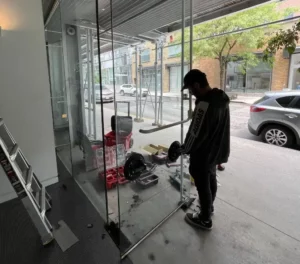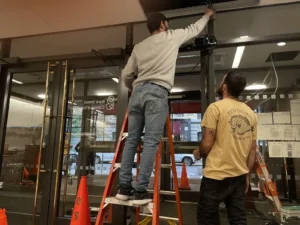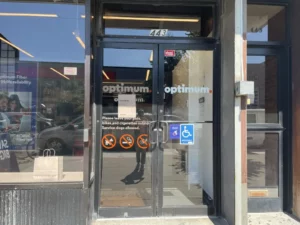
The ADA’s Requirements for Handicap-Accessible Doors in NYC : A Guide to Door Hardware and Installation

As a business owner, manager, or building manager in New York City, it’s important to comply with the Americans with Disabilities Act (ADA) requirements for handicap-accessible doors. These requirements ensure that your business is accessible to all individuals, including those with disabilities. In this article, we’ll discuss the ADA’s requirements for handicap-accessible doors in NYC, as well as how to make your existing doors accessible.
Overview of Handicap-Accessible Doors in NYC
Handicap-accessible doors are designed to accommodate individuals with disabilities, such as those who use wheelchairs or mobility devices. There are different types of handicap-accessible doors, including automatic doors, power-assisted doors, and manual doors with proper hardware.
Having handicap-accessible doors in your business has many benefits, including improving accessibility for all individuals, providing a better customer experience, and complying with ADA requirements.
ADA Requirements for Handicap-Accessible Doors in NYC
To comply with ADA requirements, handicap-accessible doors in NYC must meet certain standards. These include:
- Minimum door width: Doors must be at least 32 inches wide when open.
- Threshold height: Thresholds must be no more than 0.75 inches high.
- Door hardware requirements: Door hardware, such as handles and locks, must be operable with one hand and require no tight grasping, pinching, or twisting of the wrist.
- Clearance space: The area in front of and behind the door must have enough space for a person using a wheelchair or mobility device to maneuver.
- Maneuvering clearance: The door’s swing must provide enough space for a person using a wheelchair or mobility device to enter and exit the door.
It’s important to ensure that your handicap-accessible doors meet these requirements to ensure that your business is accessible to all individuals.
Common Mistakes to Avoid
When installing handicap-accessible doors, businesses often make common mistakes that can make the doors inaccessible. These mistakes include installing doors with hardware that is difficult to operate, using door thresholds that are too high, or failing to provide enough clearance space.
To avoid these mistakes, work with a trusted provider like Matadoor Security NYC. We can help you select the right type of door and hardware to ensure that your doors meet ADA requirements.
How to Make Existing Doors Handicap-Accessible
If you have existing doors that do not meet ADA requirements for handicap accessibility, there are several options available to make them accessible. Retrofitting existing doors with automatic openers or power-assisted devices is a popular option, as it can often be done without replacing the entire door.
Here are some types of hardware that can be installed on existing doors to make them handicap-accessible:
- Automatic Door Openers: Automatic door openers are devices that can be installed on existing doors to open and close them automatically. These devices are often activated by a push button or motion sensor and can be installed on both interior and exterior doors. Automatic door openers are particularly useful for individuals with mobility impairments, as they can enter and exit a building without assistance.
- Power-Assisted Doors: Power-assisted doors are similar to automatic door openers in that they provide assistance in opening and closing doors. However, power-assisted doors require the user to initiate the opening and closing of the door. These devices can be installed on both manual and automatic doors.
- Door Threshold Ramps: Door threshold ramps are small ramps that can be installed on the bottom of a door to make it easier for individuals with mobility impairments to cross over the threshold. These ramps can be made of various materials such as rubber, aluminum, or plastic.
- Lever Door Handles: Lever door handles are an alternative to traditional door knobs that can be difficult to grip and turn for individuals with disabilities. Lever handles require less strength and dexterity to operate, making them a good option for individuals with limited hand mobility.
- Motion Sensors: Motion sensors can be used to automatically activate automatic door openers, eliminating the need for individuals to physically push a button or pull a handle. This is particularly useful for individuals with mobility impairments or those who use wheelchairs or mobility devices.
- Remote Door Openers: Remote door openers are devices that can be used to activate automatic door openers from a distance. These devices can be especially helpful for individuals with limited mobility who may have difficulty reaching a push button or handle.
When deciding which hardware to install on your existing doors, it’s important to consider the specific needs of your business and the individuals who will be using the doors. Work with a trusted provider like Matadoor Security NYC to select the right type of hardware to ensure that your doors meet ADA requirements for handicap accessibility.
Alternatively, you can choose to install new doors that meet ADA requirements. This may be a more expensive option, but it ensures that your doors are fully compliant with ADA standards.
Making existing doors handicap-accessible is an important step in ensuring that your business is accessible to all individuals, including those with disabilities. There are several types of hardware that can be installed on existing doors to make them accessible, including automatic door openers, power-assisted doors, lever door handles, and more. To ensure that your doors meet ADA requirements, work with a trusted provider like Matadoor Security NYC to select the right type of hardware or to install new doors if necessary. Contact us today to learn more about our door installation and retrofitting services.



